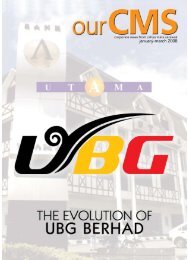Notes to the Financial Statements - Cahaya Mata Sarawak Bhd
Notes to the Financial Statements - Cahaya Mata Sarawak Bhd
Notes to the Financial Statements - Cahaya Mata Sarawak Bhd
Create successful ePaper yourself
Turn your PDF publications into a flip-book with our unique Google optimized e-Paper software.
96<br />
<strong>Notes</strong> <strong>to</strong> <strong>the</strong> <strong>Financial</strong> <strong>Statements</strong><br />
For <strong>the</strong> fi nancial year ended 31 December 2011<br />
2. Summary of signifi cant accounting policies (contd.)<br />
2.21 <strong>Financial</strong> liabilities (contd.)<br />
O<strong>the</strong>r fi nancial liabilities (contd.)<br />
For o<strong>the</strong>r fi nancial liabilities, gains and losses are recognised in profi t or loss when <strong>the</strong> liabilities are<br />
derecognised, and through <strong>the</strong> amortisation process.<br />
A fi nancial liability is derecognised when <strong>the</strong> obligation under <strong>the</strong> liability is extinguished. When an<br />
existing fi nancial liability is replaced by ano<strong>the</strong>r from <strong>the</strong> same lender on substantially different terms, or<br />
<strong>the</strong> terms of an existing liability are substantially modifi ed, such an exchange or modifi cation is treated<br />
as a derecognition of <strong>the</strong> original liability and <strong>the</strong> recognition of a new liability, and <strong>the</strong> difference in <strong>the</strong><br />
respective carrying amounts is recognised in profi t or loss.<br />
2.22 Leases<br />
(a) As lessee<br />
Finance leases, which transfer <strong>to</strong> <strong>the</strong> Group substantially all <strong>the</strong> risks and rewards incidental <strong>to</strong><br />
ownership of <strong>the</strong> leased item, are capitalised at <strong>the</strong> inception of <strong>the</strong> lease at <strong>the</strong> fair value of <strong>the</strong><br />
leased asset or, if lower, at <strong>the</strong> present value of <strong>the</strong> minimum lease payments. Any initial direct<br />
costs are also added <strong>to</strong> <strong>the</strong> amount capitalised. Lease payments are apportioned between <strong>the</strong><br />
fi nance charges and reduction of <strong>the</strong> lease liability so as <strong>to</strong> achieve a constant rate of interest on <strong>the</strong><br />
remaining balance of <strong>the</strong> liability. Finance charges are charged <strong>to</strong> profi t or loss. Contingent rents, if<br />
any, are charged as expenses in <strong>the</strong> periods in which <strong>the</strong>y are incurred.<br />
Leased assets are depreciated over <strong>the</strong> estimated useful life of <strong>the</strong> asset. However, if <strong>the</strong>re is no<br />
reasonable certainty that <strong>the</strong> Group will obtain ownership by <strong>the</strong> end of <strong>the</strong> lease term, <strong>the</strong> asset is<br />
depreciated over <strong>the</strong> shorter of <strong>the</strong> estimated useful life and <strong>the</strong> lease term.<br />
Operating lease payments are recognised as an expense in profi t or loss on a straight-line basis<br />
over <strong>the</strong> lease term. The aggregate benefi t of incentives provided by <strong>the</strong> lessor is recognised as a<br />
reduction of rental expense over <strong>the</strong> lease term on a straight-line basis.<br />
(b) As lessor<br />
2.23 Provisions<br />
Leases where <strong>the</strong> Group retains substantially all <strong>the</strong> risks and rewards of ownership of <strong>the</strong> asset<br />
are classifi ed as operating leases. Initial direct costs incurred in negotiating an operating lease are<br />
added <strong>to</strong> <strong>the</strong> carrying amount of <strong>the</strong> leased asset and recognised over <strong>the</strong> lease term on <strong>the</strong> same<br />
bases as rental income. The accounting policy for rental income is set out in Note 2.26(h).<br />
Provisions are recognised when <strong>the</strong> Group has a present obligation (legal or constructive) as a result of a<br />
past event, it is probable that an outfl ow of economic resources will be required <strong>to</strong> settle <strong>the</strong> obligation and<br />
<strong>the</strong> amount of <strong>the</strong> obligation can be estimated reliably.<br />
Provisions are reviewed at each reporting date and adjusted <strong>to</strong> refl ect <strong>the</strong> current best estimate. If it is no<br />
longer probable that an outfl ow of economic resources will be required <strong>to</strong> settle <strong>the</strong> obligation, <strong>the</strong> provision<br />
is reversed. If <strong>the</strong> effect of <strong>the</strong> time value of money is material, provisions are discounted using a current<br />
pre tax rate that refl ects, where appropriate, <strong>the</strong> risk specifi c <strong>to</strong> <strong>the</strong> liability. When discounting is used, <strong>the</strong><br />
increase in <strong>the</strong> provision due <strong>to</strong> <strong>the</strong> passage of time is recognised as a fi nance cost.<br />
Cahya <strong>Mata</strong> <strong>Sarawak</strong> Berhad







